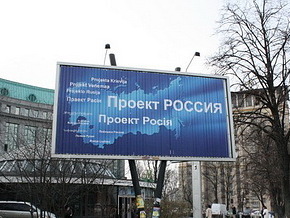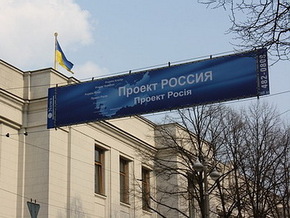“The potential of a Great country — the Power of a Great bank,” says VTB, Russia’s second-biggest bank, on a billboard in Ukraine’s capital, Kyiv.
VTB, formerly known as Vneshtorgbank (Foreign Trade Bank), has been struggling in Russia amid the world financial crisis. That hasn’t prevented it from running a bombastic ad campaign in Ukraine. For a few months, Ukrainian television has shown ads whose inherent drama links the size of VTB’s business to the size of Russia.
On this particular billboard, however, the image of “big business” that VTB aims to project becomes big politics.
Highly symbolic, the billboard pictures St. Sophia Cathedral and the Bohdan Khmelnytsky Monument on the “Ukrainian side” and the Kremlin on the “Russian side.”
St. Sophia’s Cathedral symbolizes Christianity, being one of Kyiv’s best known landmarks and one of the oldest Orthodox shrines in Ukraine.
The Bohdan Khmelnytsky Monument symbolizes Ukraine’s alliance with Russia under the Treaty of Pereyaslav, concluded on condition of autonomy but gradually eroded by Russia.
The Kremlin symbolizes the government responsible for the erosion of Ukraine’s independence and for the death of millions of Ukrainians in wars and genocide.
For a financial institution accused of being the Kremlin’s “pocket bank,” the ensemble looks pretty natural.
Assuming the river pictured is the Dnipro River, then the ad either portrays Ukraine and Russia as one “great country” or hints at Russia’s occupation of left-bank Ukraine. How’s that for a banking ad? Would Deutsche Bank run ads in Jerusalem juxtaposing the Reichstag with the Wailing Wall?
Currently, lack of customer trust makes the top of the list of why Ukrainians stay out of banks. With the hryvnia losing more than 50% of its value against the dollar in September-November 2008, customers rushed to withdraw their devalued hryvnia deposits.
Not so fast, said the National Bank of Ukraine (NBU), ordering a freeze on cash withdrawals.
Equally distressed were the many thousands of customers whose dollar-denominated loans suddenly became impossible to pay off due to an exchange rate gone wild. Meanwhile, with a little help from the National Bank, many banks used the bailout money to bet against the hryvnia, further destroying customer trust.
In other words, bank size may not be that big of an issue. During the last couple of years, major Ukrainian banks have been acquired by big European ones. Yet, for some reason, instead of addressing the issue of customer trust, VTB decided to bank on Russian imperialistic imagery. What a way to set yourself apart from the competition.
The billboard’s proximity to the city’s only remaining Lenin Monument adds another ironic edge to the story. In February 1918, the Bolshevik army shelled and pillaged Kyiv, seeking to overthrow a Ukrainian government that had declared independence from Russia. In March 1918, Lenin moved the Bolshevik government headquarters from the Smolny Institute in Petrograd to the Kremlin in Moscow.
So what target market does VTB have in mind? Pro-Kremlin Ukrainians or Ukrainians with a short memory/poor knowledge of history?
Even more outrageous ads had mushroomed in downtown Kyiv last month: “Project Russia.”

The ads, complete with a map that displayed Ukraine as part of Russia, sprang up outside the Verkhovna Rada, Ukraine’s parliament. Behind these ads, it turned out, was Warriors of Creativity, a Russian movement that celebrates creativity in communications.
Their $9M anti-Ukrainian campaign had kicked off with “American salo,” a series of teaser-hate ads placed in the Moscow subway.
A book of the same title soon found its way to the Russian State Duma and the Verkhovna Rada. What makes salo “American” is obviously the Orange Revolution. Many Russians use the word salo as a gastro-ethnic slur for Ukrainians and widely believe the Orange Revolution to be an American plot.
Interestingly, some people in the Russian blogosphere totally missed the creative thrust of “American salo.”
Back in Kyiv, the SBU, the Ukrainian security service, soon ordered the “Project Russia” ads removed. Will the SBU respond creatively this time?
Note: I took the VTB billboard pictures on May 3.
Sources:
http://www.ft.com/cms/s/0/c3549190-f818-11db-baa1-000b5df10621.html?nclick_check=1
http://uk.reuters.com/article/rbssFinancialServicesAndRealEstateNews/idUKLD8357920090513
http://vovremya.info/news/1239105706.html
http://forum-msk.org/material/news/840172.html
http://www.liberty.ru/foto/Operaciya-Amerikanskoe-salo/Operaciya-Amerikanskoe-salo
http://nikolay-smeh.livejournal.com/114430.html
Monday, May 18, 2009
Russian Imperialist Ads Appear and Disappear in Kyiv
Subscribe to:
Post Comments (Atom)







2 comments:
Odd advertising indeed - put your money into a bank that has the "safety" of the Kremlin behind it.
No thanks!
Even better -
President Yushchenko has called for the removal of all soviet communist symbols/monuments in Ukraine.
Here it is in Ukrainian:
http://www.pravda.com.ua/news/2009/5/17/94847.htm
In English:
http://blog.kievukraine.info/2009/05/ukrainian-leader-calls-for-cleansing-of.html
KIEV, Ukraine -- Ukrainian President Viktor Yushchenko called for communist statues to be removed and Soviet street names to be changed. It came in a speech on the country's Remembrance Day for the Victims of Political Repression.
Hammer and sickle in the Kiev Arsenalna metro (subway) station.
The president attended a memorial service at the Bykivnia mass grave on the outskirts of Kiev, where up to 150,000 people executed in the Stalinist purges were buried.
"Ukraine must once and for all cleanse itself of the symbols of the regime that massacred millions of innocent people. There can be no justification for this - it is not a part of our history, as some cynical people would say, it is a part of the communist system, and symbols of murder," he said.
I support Yushchenko’s initiative to the extent that it targets monuments to Communist Party leaders: Lenin, Petrovsky, Kosior, Uritsky, et al. These monsters belong in museums.
Museums should play an important role in preventing history from repeating itself.
Ukrainians should know what the Communist Party did and how it came to power. As a matter of principle, Yushchenko should have addressed the issue of his membership in the Communist Party.
Upon graduating from college in 1975, Yushchenko did a stint in the Border Guard Forces (controlled by the KGB) and then joined the Communist Party in 1977.
In summary, the monsters must go, but the graves of Red Army soldiers should remain intact.
Post a Comment